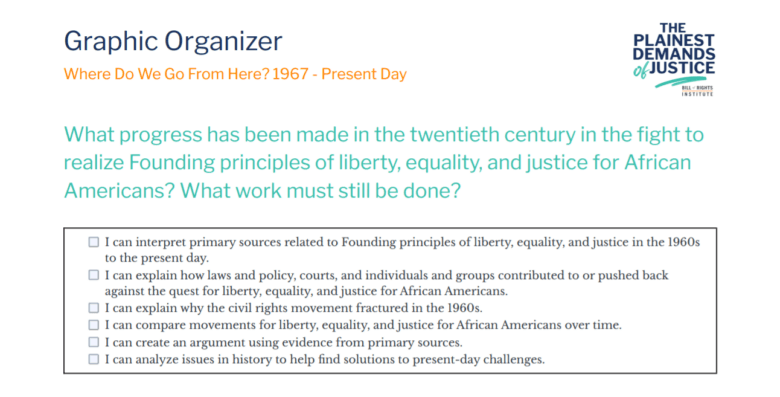Graphic Organizer: Primary Sources in Lesson 6, Plainest Demands of Justice
What progress has been made in the twentieth century in the fight to realize Founding principles of liberty, equality, and justice for African Americans? What work must still be done?
- I can interpret primary sources related to Founding principles of liberty, equality, and justice in the 1960s to the present day.
- I can explain how laws and policy, courts, and individuals and groups contributed to or pushed back against the quest for liberty, equality, and justice for African Americans.
- I can explain why the civil rights movement fractured in the 1960s.
- I can compare movements for liberty, equality, and justice for African Americans over time.
- I can create an argument using evidence from primary sources.
- I can analyze issues in history to help find solutions to present-day challenges.
Directions: Identify the main ideas and connections to the Founding principles using the information you gathered from your assigned documents.
| Document Title and Date | Main ideas | Connection to or Violation of Founding Principles |
|---|---|---|
| Black Panther Party, “Ten Point Program,” 1966 | ||
| Stokely Carmichael and Charles Hamilton, Black Power: The Politics of Liberation in America, 1967 | ||
| Martin Luther King, Jr., “Where Do We Go From Here?”, 1967 | ||
| Images of 1968 Riots, Washington, DC | ||
| Civil Rights Act, 1968 | ||
| Tommie Smith and John Carlos at the 1968 Olympics, October 17, 1968 | ||
| Griggs v. Duke Power, 1971 | ||
| Justice Lewis Powell, Decision of the Court, Regents of U. of California v. Bakke, 1978 | ||
| Justice Thurgood Marshall Dissent, Regents of U. of California v. Bakke, 1978 | ||
| Civil Rights Act, 1991 | ||
| Barack Obama, “A More Perfect Union,” 2008 | ||
| Black Lives Matter, “Herstory,” 2014 | ||
| Fisher v. U. of Texas, 2016 | ||
| Nikole Hannah-Jones, The 1619 Project, 2019 | ||
| Robert Woodson, “The Crucial Voice of 1776,” 2020 | ||
| John Lewis, “Together, You Can Redeem the Soul of Our Nation,” 2020 |
